Day 2, The Sacred and the Profane
I put on the same jeans as the night before and select a new shirt. I pack my backpack with the camera, the guide book, and anything I think I’ll need for the day, then I go downstairs. I missed breakfast by about 15 minutes, and I’ve already read reviews of the 3 Ducks that say, “if you miss breakfast, don’t bother talking them into making an exception.”
I don’t talk to anyone on the way out. I put my jacket on and walk up commerce, now becoming somewhat familiar with the sequence of shops. I wave to the cheeseshop owner I met the day before, but he doesn’t seem to recognize me. The trucks unload, people walk their dogs, and I still can’t hear any evidence that announces the enormity of this metropolis.
I reach the corner of La Motte-Picquet and Grenelle and find a little cafe called “Le Paris”, which offers Prix Fixe breakfast menus for under 10E. I sit at a table and order the “petit dejeuner a l’anglaise”, which means orange juice, a baguette with butter and strawberry jam, two eggs sunny-side up over a nice piece of ham, and a croissant. Very good. As I eat I noticed many Frenchmen who come in and stood at the bar to have their breakfast. They order only the baguettes with butter and coffee, and they eat very fast. They sugar their coffee with two or three packs, then throw the packs onto the floor. Bits of paper and bread leave no floor exposed, and I wondered why they don’t sweep it up. I order a cafe au lait and as I drink it I see the list of prices for drinks. The cafe au lait I’m drinking (probably 4-6 ounces) is 3,50E. If I had ordered it at the bar it would have been 1,70E.
At the metro station I buy a “Carnet”, which means rather than 1,40E for a single ride, I pay 10,40 for 10 rides. Quite a discount. I take line 6-Etoile to Etoile, then get on the 2-Nation, and exit at Pigalle.
It always takes a few minutes to get oriented when I hit the street level. It’s taken me the whole time since I’ve been here to remember to look on the side of the building for the name of the street, not to some pole on the corner like in America. After I find Rue Jean-Baptiste Pigalle, I head up Clichy. This street reminds me of Broadway as it runs through Times Square, except with shorter buildings and fewer lights. Something in the density of the buildings and big-city atmosphere make me think of it. Restaurants, one after another, lay on the right-hand side of the street. Across the multi-lane boulevard are the sex shops. Little theaters, peep shows, DVD outlets, and clubs. They’re all dark at the moment, though occasionally people move in and out of the curtained doorways. On my right is the Moulin Rouge, so large I can’t see it. I walk into the red-draped lobby and check out the posters behind the glass. Pictures of dancing girls from the past 100+ years decorate the entrance, as does the price. It’s about 400E to have the full experience, and about 70E to just have dinner and a show. I don’t look into what the difference was between the two.
Walking further up Clichy, I decide to cross the street so I could get a better view of the Moulin. I can see the sex shops up close now, and I’m surprised at how similar they are to the ones here. They’re seedy, low-budget, and all the signs are in English. All of them. I pass a lingerie shop and a club. That’s when I notice that, since I left the metro, I haven’t seen a boulangerie, a cave, a fromagerie, a chocolatier, or a boucherie. There also aren’t any restaurants on this side of the street. Oh wait, there’s a cafe Americaine. I get my picture and cross back to where Clichy meets Avenue Rachel. That’s where you go to enter the Cimetiere Montmartre. At the corner is a place called Cafe Maestro. I take a picture because I’m silly (Maestro is my handle on a lot of sites, though I'm trying more and more to divorce myself from it).

I turn right onto Ave Rachel and there’s the entrance to the cemetery. It’s an open gateway surrounded by little cafes and a fruit stand. Above it all is rue Caulaincourt, a green metal bridge running over a diagonal of the cemetery. From the map this makes it look like the cemetery is divided into two parts, one larger one the left, smaller on the right. Walking toward it I start to see mausoleums and graves, and people milling about in front of the map.
From my guide book I know I’m supposed to go to the back and work my way forward, but of course I don’t do that. I go to the right, to enter the small area on the right side of the Caulaincourt bridge. On the map this looks like a small area, but it stretches on, row after row of graves. Several are gothic, standing eight to fifteen feet high, most including a small chapel area inside where flowers or candles rest inside. Some have locked doors, but most are open.
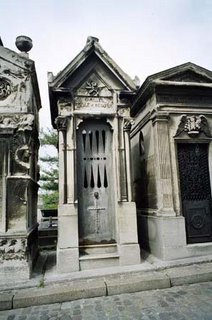
Where the doors are open the smell of urine seeps through as I pass, so I turn to have a closer look. Coke bottles, beer bottles, and papers from sandwich wraps and crisps litter the floors under the iron cross hanging on the back wall. I haven’t seen the name of the grave, but the oval stained glass image of Jesus stretching his arms out over the cross below give me an idea of what the family intended this tomb to represent. I back out of the sepulchre.

Midway between the southeast corner to the point under the Caulaincourt bridge, I am stopped by a grave I can’t believe. A pure-white marble statue stands under the name Dalida--a modern woman wearing what looks like an evening gown. Black marble pedestals with perfectly manicured shrubs lay about, like an audience. Her face shows determination, confidence, and under the beams of a golden sun on a black monolith behind her, she looks as though she is seconds from singing Opera or reciting Moliere. I stand for two or three minutes, trying to capture her best angle, to guess at her history, but I’m unable to derive anything from what is written on the grave. 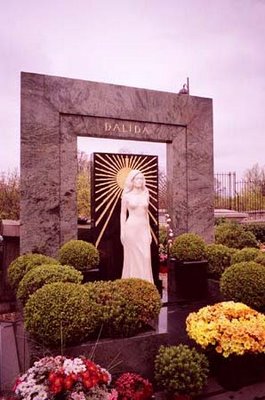
Two American girls come by from behind me. They say “That’s cool!” and move on. Their feet don’t stop. 
Descending to the left and back toward the bridge, I try to discern a pattern of where the old graves and the new graves are separate, but I can’t find any. It looks as though the intent all along has been to mix the old and the new, with simple gray stone sepulchres and elaborate pink granite tombs within feet of another. “Stick-figure Christ” is another example of the modernity. It’s on the back of a grave, a thin black cross, with the extra crossbar at the top, hanging from which is a slumped over stick figure, round head descending to a lightning-bolt shape, leafed in gold. I can’t at all decide how I feel about this. 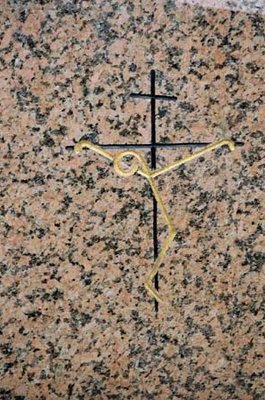
Crossing under the bridge, I find that the graves underneath do tend to be older. Several sculptures adorn the graves of French nobility. I don’t know the names, but their importance is etched into their resting-places, usually with other people standing around weeping or dropping flower petals around. So far, except for Dalida, this cemetery seems to me much more interesting than the ones in New Orleans, except that I expected the graves here to be much older. The earliest death I’ve seen so far dates after the mid XIX century, whereas in New Orleans we saw from from the early XVI.
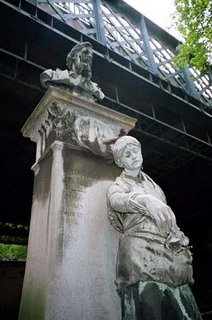 Then I turn and see a Weeping Widow, one of those mentioned in the tour book, on the grave of Henri Meilhac. She’s made of some kind of stone, not marble, sitting over the grave and holding a wreath. She is naked save for the hooded cape drawn over her, sitting up straight as though strapped to a board. She cradles her face in her left hand. Looking closely at her face, I see large lips and a strong chin, and I begin to wonder if she’s not modeled after an Algerian or a someone from the Code d’Ivoire, but there is no way to know.
Then I turn and see a Weeping Widow, one of those mentioned in the tour book, on the grave of Henri Meilhac. She’s made of some kind of stone, not marble, sitting over the grave and holding a wreath. She is naked save for the hooded cape drawn over her, sitting up straight as though strapped to a board. She cradles her face in her left hand. Looking closely at her face, I see large lips and a strong chin, and I begin to wonder if she’s not modeled after an Algerian or a someone from the Code d’Ivoire, but there is no way to know. 
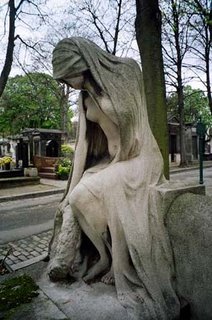 I wander around for a time, finding various sculpture and stopping occasionally to record an observation or take a picture. In the roundabout that used to mark the cemetery’s main entrance, tombs from every conceivable European origin lay around. One looks like a European influenced Mosque, with a pink minaret sitting atop a bulbous mausoleum, fronted by an elaborate wrought-iron gate. The name definitely does not look French.
I wander around for a time, finding various sculpture and stopping occasionally to record an observation or take a picture. In the roundabout that used to mark the cemetery’s main entrance, tombs from every conceivable European origin lay around. One looks like a European influenced Mosque, with a pink minaret sitting atop a bulbous mausoleum, fronted by an elaborate wrought-iron gate. The name definitely does not look French. 
Walking toward the back, where the tour says to begin, I’m on the lookout for a picture I saw in the tour book, that of a young woman laying supine over a grave in grief. I haven’t seen her yet, and I don’t want to miss her, so I have an eye out always. Several greened-copper statues lay about, and I spend a little time with each one.

 Truffaut is also buried here somewhere. The only film of his I’ve seen is the 400 Blows, but that's one of those films that lingers and takes over and crawls around in my head. I can’t leave without seeing him.
Truffaut is also buried here somewhere. The only film of his I’ve seen is the 400 Blows, but that's one of those films that lingers and takes over and crawls around in my head. I can’t leave without seeing him.
I see a gardener and ask him about the statue of the girl from the book. He says he doesn’t know her, and he doesn’t know many of the graves around here. He looks like many of the charming old French men I’ve seen: tweed jacket, a small gray cap, a white beard, and a sunken, freckled face. He looks like someone who has spent his life studying people and living well. He seems to have no problem understanding my French or giving me directions to where I can look for a map. For some reason I don’t want a map, I want to find everything by directions or by feel (in the cemetary, that is, not in all of Paris!). I will come to regret this after I’m back home.
Where is she??
Labels: paris

2 Comments:
I love the 'Dalida' monument. You are totally right, it's like an audience, and it's awesome.
randomly found your blog..but just wanted to let you know, Dalida was a very famous singer in France and throughout the world, never had much success in America though. She was born in Egypt of Italian ancestry.
Post a Comment
<< Home